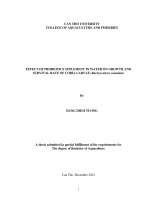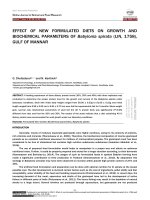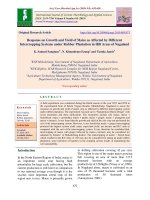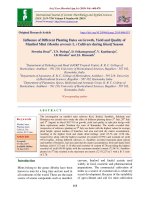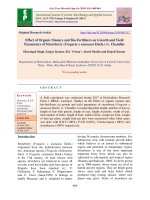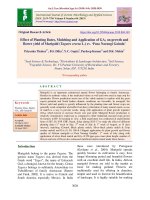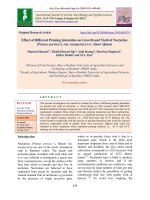Effect of different salinities levels on growth and survival of Indian white shrimp (Fenneropenaeus indicus)
Bạn đang xem bản rút gọn của tài liệu. Xem và tải ngay bản đầy đủ của tài liệu tại đây (363.75 KB, 10 trang )
Int.J.Curr.Microbiol.App.Sci (2018) 7(7): 2295-2304
International Journal of Current Microbiology and Applied Sciences
ISSN: 2319-7706 Volume 7 Number 07 (2018)
Journal homepage:
Original Research Article
/>
Effect of Different Salinities Levels on Growth and Survival of Indian
White Shrimp (Fenneropenaeus indicus)
Jesing G. Vanza1*, Haresh G. Solanki2, Ritesh V. Borichangar2,
Rajesh B. Vala3 and Mihir R. Patel3
College of Fisheries Science, Navsari Agricultural University, Navsari, Gujarat, India
*Corresponding author
ABSTRACT
Keywords
Indian white
shrimp, Salinity,
Growth survival
Article Info
Accepted:
xx June 2018
Available Online:
xx July 2018
The present experiment evaluated the effect of different levels of salinities on growth and
survival of post larvae (PL) of Fenneropenaeus indicus, commonly known as Indian white
shrimp. PL was stocked at six different salinities levels i.e., 15, 20, 25, 30 35 and 40 ppt
(T1, T2, T3 T4, T5 and T6, respectively) and reared for a period of 60 days. Water quality
parameters and growth performance parameters of different treatments were compared
during the experiment. A significant (p<0.05) decrease in growth and survival
concentration relative with the higher and lower salinities level was observed. Though
some of the parameters showed significant (p<0.05) difference among the treatments, the
water quality remained within optimum level, throughout the experiment. Increase in
salinity levels led to significant reduction (p<0.05) in ABW and survival of PL. Treatment
T3 (water salinity 25 ppt) and treatment T4 (water salinity 30 ppt) were found at par with
each other and significantly better than rest of the treatments in all the periods barring “0”
DOC. T3 and T4 recorded higher mean body weight at 60 DOC during both the years
2016-17 (0.427 and 0.402 g), 2017-18 (0.577 and 0.505 g) as well as in pooled results
(0.502 g and 0.454g) as compared to rest of the treatments. Survival rate of treatment T4
was significantly higher than other treatments while lowest survival was found in
treatment T1 and T6.
Introduction
Shrimp culture in Gujarat is dominated by
vannamei shrimp culture because of its higher
growth rate than other shrimp species. This
species requires low salinity (15-20 ppt) and
28-320C for their optimum growth. Because of
this preference, vannamei shrimp cannot be
cultured economically during the winter
season and high saline environments. Also, the
higher salinity and low temperatures causes
stress to vannamei shrimp and ultimately
several disease outbreaks are encountered.
Because of this reason, the winter crop is a
fallow period in Gujarat. The previous year
trials of this Indian white shrimp during
monsoon and winter season at DantiUmbharat farm and the available literature
2295
Int.J.Curr.Microbiol.App.Sci (2018) 7(7): 2295-2304
shows that this species can be cultured well
during winter season when the salinity
remains high and temperature remains low.
The salinity range and tolerance of this species
is an essential criterion for further refining the
culture technology of this species in this
region. So the above experiment is proposed.
The successful raising of Indian white shrimp
during the monsoon crop during the year 2016
and it‟s tolerance towards high salinity and
low temperatures, have paved the way for a
filler trial of this species in this region. The
species have shown to thrive under higher
salinities during the initial period of stocking
yielding approximately 1000 kgs per ha at 10
species stocking density per sq. m.
In shrimp culture system salinity is considered
to be the major factor influencing growth and
survival.
As per the Kinne (1971) pointed out, salinity
is the major environmental factor whereas the
temperature fluctuations characteristic to the
tropics are not significant. George (1968) also,
has proved that salinity, perhaps more than
any other, is the single factor affecting
shrimps in the brackish water shrimp culture.
It is also a factor known to influence the
efficiency of a species to utilize the food given
(Kalyanaraman and Paul Raj, 1984),
Therefore studies of the responses of the
shrimps to the changes in environmental
conditions, especially salinity, are essential to
determine optimum conditions for successful
shrimp farming. High output can be achieved
only by exerting control over the environment
by reducing stress conditions (Wikins, 1976).
black tiger shrimp P. monodon are the most
popular.
In India, F. indicus is one of the prominent
species used for semi-intensive shrimp culture.
An
understanding
of
the
optimal
environmental requirements of the species is
one of the prime necessities in any culture
operation. Brackish water organisms are
generally endowed with wide range of
adaptability to withstand extreme fluctuations
in physical conditions, especially so in the
case of salinity. Salinity is a most important
factor that is known to influence the efficiency
of a species in food utilization and growth
(Kalyanaraman and Paul Raj, 1984).
Therefore it is necessary to understand the
extent of the influence of salinity on the
growth and survival by the cultured organism.
It is more significant, because growth and
survival are one of the major factors in shrimp
farming. Hence, it was found necessary to
study the effect of salinity on growth and
survival on F. indicus.
Zein Eldin (1963) found that under conditions
of constant temperature and restricted food
supply penaeid post larvae survived and grew
over a wide range of salinity (2-40 ppt).
Earlier studies have highlighted that salinity
influences the survival and growth of penaied
post larvae and juveniles (Nair and
Krishnankutty, 1975; Verghese et al., 1975;
Bhattacharya and Kewalramani 1976;
Kuttyamma 1982; Lakshmi Kanthan 1982;
Raj and Raj, 1982; and Subramanian and
Krishnamurthy, 1986).
Materials and Methods
Experimental site
Of the 27 species of shrimps belonging to
Penaeidae occurring in Indian coastal waters,
11 species have been reported to be suitable
for culture (Rao, 1983). Among these, the
Indian white shrimp Penaeus indicu and the
The present experiment was conducted for a
period of two months (60 days) from Aug to
Sep 2016 and 2017 in different levels of
salinity at CSSRS (Coastal Soil Salinity
2296
Int.J.Curr.Microbiol.App.Sci (2018) 7(7): 2295-2304
Research Station) Danti-Umbharat,
Navsari.
NAU
In this experiment, 24 crate each having an
area of 60.5cm x 40.5cm X 33.0 cm has been
setup in the wet laboratory of CSSRS, Danti
Umbharat farm. Each crate was fitted with
covered at the top to prevent escape of shrimp
by jumping and bird predation. The crates
were filled with water of different salinities as
per the treatments after 72 hrs of bleaching.
The whole crates were provided with aeration
by air pipe through the aerator.
Shrimp seed stocking:
In the present study, we tested six different
salinities like 15 ppt, 20 ppt, 25 ppt, 30 ppt, 35
ppt and 40 ppt as T1, T2, T3, T4, T5 and T6
respectively, four replication for each
treatment. All the carets were stocked with F.
indicus @ 10 pcs. per crate. The seeds
received from CIBA hatchery were stocked in
the
ponds
following
the
standard
acclimatization procedure. The seeds were
stocked in the morning around 08.00 hrs.
In brief, hatchery produced F. indicus,
averaging 0.092 ± 0.001 g (mean ± SEm) were
transported to the experimental site by
oxygenated polyethylene bags and they were
kept in 1000 lit capacity tank after proper
acclimation with environment and then initial
length and weight of shrimp seed were
recorded individually in „cm‟ and „g‟ with the
help of a measuring scale and a digital
electronic balance respectively. Finally, the
seeds were randomly stocked in each crates as
per
the
treatments
were
recorded
simultaneously. During the study period, dead
shrimp were recorded and removed quickly.
The carets were cleaned by siphoning pipe at
every day for cleaning purposes and remove
fecal matter and other uneaten feed. The seeds
were fed four times a day at a rate of 10% of
body weight.
Sampling and data analysis
Physico-chemical parameters of water such as
temperature (°C), pH, hardness (mg/L) and
total alkalinity (mg/L) were monitored weekly
in the morning between 8 and 9 a.m. during
the whole experimental period APHA (1992).
Water temperature was recorded with a glass
Celsius thermometer, pH was measured using
a digital pocket pH meter. Other chemical
parameters were measured using a titration
method.
After 60 days of trial, the whole shrimps were
harvested by scoop netting and then shrimps
were counted, measured and weighed for each
caret. To determine the growth response, yield
and survivability of experimental shrimp, the
following parameters were calculated:
Weight gain (WG) = final shrimp weight (g)initial shrimp weight (g)
Weight gain (%) = (final weight-initial
weight) × 100/initial weight
Average daily weight gain (ADWG) = (final
shrimp weight-initial shrimp weight)/days
Results and Discussion
Mean periodical weight (g):
During the 60 days of experimental period, all
the treatment effect was significant on average
body weight (g) during individual year as well
as in pooled analysis. Treatment T3 (water
salinity 25 ppt) and treatment T4 (water
salinity 30 ppt) were found at par with each
other and significantly better than rest of the
treatments in all the periods barring “0” DOC.
T3 and T4 recorded higher mean body weight
at 60 DOC during both the years 2016-17
(0.427 and 0.402 g), 2017-18 (0.577 and 0.505
g) as well as in pooled results (0.502 g and
0.454g ) as compared to rest of the treatments
(Table 3 and Fig. 1).
2297
Int.J.Curr.Microbiol.App.Sci (2018) 7(7): 2295-2304
Mean periodical length (cm)
Periodical mean body length results are
reported in table 4 revealed that all the
treatment effect was not significant on mean
body length (cm) during individual year as
well as in pooled analysis. Similar to mean
body weight, length also followed the similar
trend with treatment T3 (water salinity 25 ppt)
and treatment T4 (water salinity 30 ppt) were
found at par with each other and significantly
better than rest of the treatments. T3 and T4
recorded higher mean body length at 60 DOC
during both the years 2016-17 (3.995 and
3.880 cm), 2017-18 (3.623 and 3.565 cm) as
well as in pooled results (3.809 cm and 3.723
cm) as compared to rest of the treatments (Fig.
2).
Periodical mean survival rates (%):
After 60 days of trial, survival rate of
treatment T4 was significantly higher than
those from treatments T1, T2, T3, T5 and T6.
Survival rate of treatment T4 was significantly
higher than other treatments while lowest
survival was found in treatment T1 and T6.
Periodical mean survival rate results are
reported in table 5 revealed that all the
treatment effect were not significant on mean
survival rate (%) during individual year as
well as in pooled analysis. Treatment T4
(water salinity 30 ppt) was found to be
significantly better than rest of the treatments
in all the periods barring “0” DOC. Treatment
T4 and T3 recorded higher periodical mean
survival rate at 60 DOC during both the years
2016-17 (95.00 % and 95.00%), 2017-18
(95.00% and 92.50%) as well as in pooled
results (95.00% and 93.75%) as compared to
rest of the treatments (Table 5 and Fig. 3).
Y X T interaction was found significant in all
the periods for mean body weight and mean
survival barring mean body weight at “0”,
“15” and “30” DOC. Whereas, the interaction
was found significant in all the periods mean
body length barring mean body weight at “0”
DOC. It can be observed from table 3 and 4
that the treatments T3 and T4 gave consistently
better effect than rest of the treatments in all
the periods (Mean body weight and mean
body length).
The significance of interaction was observed
due to inconsistent effect due to treatments
other than treatment T3 and T4. Therefore,
treatments T3 and T4 were found to be the best
amongst all the treatments for mean body
weight, mean body length and survival rate in
different periods.
Physico-chemical
analysis
parameters
of
water
The data presented in table 2 showed that
there were no significant differences in values
amongst the treatments.
Weekly water
samples were collected from the experiment
and analyzed for pH and alkalinity. Whereas
water temperature data like air temperature,
surface and bottom were taken on site using
thermometer. Physico-chemical parameters at
both the locations did not significant
variations and within the optimum range.
Economics:
As L x T interaction was not significant, the
economics was calculated on the basis of
pooled
results
under
investigation.
Considering the seed yield of F. indicus, cost
of feed, cost of labor, per seed cost, gross
income, net income and BCR were computed.
The results showed that among the treatments,
highest net returns of Rs. 4.92/m2 and Rs.
3.86/m2 was realized with recommended water
salinity level (T3-25 ppt and T4-30 ppt). The
Benefit Cost (BC) ratio per sq. m. for the
treatment T3 (1:1.20) is higher than those of
all other treatments (Table 6).
2298
Int.J.Curr.Microbiol.App.Sci (2018) 7(7): 2295-2304
Table.1 Details of experiment
Experimental Details
Date of stocking
Duration of experiment (days)
Date of observations
Year
2016
05-08-2016
60
05/08/2016; 19/08/2016; 03/09/2016;
18/09/2016; 03/10/2016
03/10/2016
Date of harvesting
Water exchange
Feeding schedule
2017
19-9-2017
60
19/09/2017; 03/10/2017;
18/10/2017; 02/11/2017;
17/11/2017
17/11/2017
Every day @ 50%.
4 times/day @ 10% body wt.
Table.2 Water temperature and quality parameters
Treatments
Parameters
T1
pH
Alkalinity (ppm)
Temp (°C)
pH
Alkalinity (ppm)
Temp (°C)
pH
Alkalinity (ppm)
Temp (°C)
pH
Alkalinity (ppm)
Temp (°C)
pH
Alkalinity (ppm)
Temp (°C)
pH
Alkalinity (ppm)
Temp (°C)
T2
T3
T4
T5
T6
Year 2016
Mean±SD
8.31±0.204
194.68±12.791
24.13±1.264
8.24±0.245
205.41±16.255
23.81±1.449
8.41±0.195
196.13±14.186
24.16±1.156
8.18±0.159
184.44±23.593
24.06±1.259
8.23±0.176
203.74±24.985
23.75±1.277
8.21±0.198
203.44±15.401
24.19±1.349
2299
Year2017
8.21±0.129
198.88±32.339
20.16±1.152
8.14±0.055
169.46±18.618
20.69±1.899
8.30±0.163
159.34±4.926
20.41±1.954
8.13±0.072
173.31±21.198
21.06±1.592
8.16±0.099
173.26±6.907
20.09±1.216
8.11±0.113
175.80±17.234
20.56±1.517
Int.J.Curr.Microbiol.App.Sci (2018) 7(7): 2295-2304
Table.3 Effect of different treatments on mean weight (g) of Indian white shrimp (mean of 5 nos)
Weight (g)
Day of Culture (DOC)
Treatment
/Year
2016
2017
Pooled
2016
2017
Pooled
2016
2017
Pooled
2016
2017
Pooled
2016
2017
Pooled
T-1
0.092
0.126
0.109
0.095
0.172
0.133
0.116
0.236
0.176
0.205
0.299
0.252
0.298
0.362
0.330
T-2
0.091
0.127
0.109
0.099
0.183
0.141
0.128
0.258
0.193
0.230
0.304
0.267
0.333
0.350
0.342
T-3
0.093
0.127
0.110
0.117
0.209
0.163
0.166
0.295
0.230
0.277
0.413
0.345
0.427
0.577
0.502
T-4
0.091
0.125
0.108
0.105
0.194
0.149
0.139
0.276
0.208
0.252
0.391
0.322
0.402
0.505
0.454
T-5
0.091
0.125
0.108
0.101
0.177
0.139
0.133
0.248
0.190
0.235
0.312
0.274
0.359
0.376
0.367
T-6
0.092
0.127
0.109
0.099
0.170
0.135
0.126
0.243
0.184
0.220
0.282
0.251
0.314
0.321
0.318
SEm±
0.001
0.001
0.001
0.001
0.005
0.003
0.002
0.006
0.003
0.002
0.005
0.017
0.003
0.005
0.029
CD@ 5%
NS
NS
NS
0.003
0.014
0.008
0.006
0.002
0.009
0.007
0.016
0.060
0.008
0.015
0.105
CV (%)
1.92
1.41
1.63
2.49
5.14
4.83
3.02
4.21
4.18
1.91
3.14
2.83
1.44
2.47
2.10
SEm±
CD @
5%
NS
SEm±
CD @
5%
NS
SEm±
CD @
5%
NS
SEm±
CD @
5%
0.012
SEm±
CD @
5%
0.012
YXT
O-DOC
0.001
15-DOC
0.004
30-DOC
0.004
* Value in the parenthesis are original mean value
2300
45-DOC
0.004
60-DOC
0.004
Int.J.Curr.Microbiol.App.Sci (2018) 7(7): 2295-2304
Table.4 Effect of different treatments on mean length (cm) of Indian white shrimp (mean of 5 nos)
Length
(cm)
Treatment
/Year
Day of Culture (DOC)
2016
2017
Pooled
2016
2017
Pooled
2016
2017
Pooled
2016
2017
Pooled
2016
2017
Pooled
T-1
2.515
2.955
2.735
2.605
3.095
2.850
2.800
3.241
3.021
3.010
3.390
3.200
3.370
3.543
3.456
T-2
2.525
2.975
2.750
2.685
3.093
2.889
2.960
3.248
3.104
3.330
3.388
3.359
3.750
3.530
3.640
T-3
2.530
2.955
2.743
2.640
3.080
2.860
2.990
3.335
3.163
3.395
3.528
3.461
3.995
3.623
3.809
T-4
2.550
2.990
2.770
2.810
3.125
2.967
3.135
3.295
3.215
3.460
3.468
3.464
3.880
3.565
3.723
T-5
2.545
2.970
2.756
2.765
3.060
2.913
3.045
3.220
3.133
3.385
3.345
3.365
3.780
3.472
3.626
T-6
2.535
2.980
2.758
2.735
3.112
2.923
3.065
3.268
3.166
3.365
3.390
3.378
3.560
3.510
3.535
SEm±
0.016
0.017
0.011
0.024
0.023
0.037
0.025
0.028
0.055
0.025
0.023
0.076
0.025
0.020
0.104
CD@ 5%
NS
NS
NS
0.072
NS
NS
0.075
NS
NS
0.075
0.068
NS
0.074
0.060
NS
CV (%)
1.25
1.15
1.19
1.79
1.46
1.61
1.69
1.71
1.70
1.52
1.33
1.42
1.33
1.14
1.25
SEm±
CD @
5%
NS
SEm±
CD @
5%
0.067
SEm±
CD @
5%
0.077
SEm±
CD @
5%
0.069
SEm±
CD @
5%
0.065
O-DOC
YXT
0.016
15-DOC
0.023
30-DOC
0.027
* Value in the parenthesis are original mean value
2301
45-DOC
0.024
60-DOC
0.023
Int.J.Curr.Microbiol.App.Sci (2018) 7(7): 2295-2304
Table.5 Effect of different treatments on survival (%) of Indian white shrimp (mean of 5 nos)
Survival
(%)
Treatment/
Year
Day of Culture (DOC)
2016
T-1
T-2
T-3
100
100
100
100
100
100
100
100
100
87.50
90.00
97.50
92.50
95.00
100.00
90.00
92.50
98.75
80.00
85.00
95.00
77.50
87.50
100.00
78.75
86.25
97.50
77.50
85.00
95.00
52.50
85.00
95.00
65.00
85.00
95.00
75.00
82.50
95.00
50.00
72.50
92.50
62.50
77.50
93.75
T-4
T-5
T-6
SEm±
100
100
100
0.000
100
100
100
0.000
100
100
100
0.000
97.50
95.00
85.00
2.946
100.00
97.50
90.00
1.863
98.75
96.25
87.50
1.651
95.00
92.50
82.50
4.167
97.50
87.50
77.50
2.826
96.25
90.00
80.00
2.476
95.00
90.00
77.50
4.167
97.50
90.00
77.50
4.249
96.25
83.75
72.50
5.244
95.00
85.00
72.50
4.330
95.00
65.00
55.00
3.436
95.00
75.00
63.75
5.000
CD@ 5%
CV (%)
NS
0.00
SEm±
NS
0.00
CD @
5%
NS
NS
0.00
8.754
6.40
SEm±
5.537
6.89
CD @
5%
NS
4.715
5.25
NS
9.43
SEm±
8.397
6.43
CD @
5%
NS
7.072
8.08
12.38
9.62
SEm±
12.625
10.73
CD @
5%
12.077
19.067
10.15
12.86
10.29
SEm±
10.209
9.59
CD @
5%
11.218
18.178
10.03
YXT
0.000
O-DOC
2017
Pooled
2016
2.465
15-DOC
2017
Pooled
2016
6.560
30-DOC
2017
Pooled
2016
45-DOC
2017
Pooled
4.208
2016
3.909
60-DOC
2017
Pooled
Table.6 Economics cost of production (per sq.m. basis)
Treatments
Average
biomass per
crate (g)
Biomass
(g) per
m2
Total
Feed
(g)
1.32
5.39
9.8
T1
2.74
11.16
11.4
T2
8.04
32.81
15.5
T3
7.26
29.61
14.2
T4
2.94
12.00
12.4
T5
1.27
5.19
10.0
T6
Seed cost
- Rs. 0.30/ PL animal
Feed cost
- Rs. 84 Rs/kg
Shrimp market price- Rs. 400 Rs/kg
Sale (Rs)
Seed
cost
(Rs)
Feed
cost
(Rs)
Total
operational
costs (Rs)
Gross
income
(Rs)
Net
income
(Rs)
BC
ratio
per kg cost
of
production
FCR
2.15
3.00 0.181
3.181
-1.03
-4.21
-1.32
0.591
7.39
4.46
3.00 0.375
3.375
1.09
-2.29
-0.68
0.302
4.17
13.12
3.00 1.102
4.102
9.02
4.92
0.125
1.93
1.20
11.85
3.00 0.995
3.995
7.85
3.86
0.97
0.135
1.96
4.80
3.00 0.403
3.403
1.40
-2.01
-0.59
0.284
4.22
2.07
3.00 0.174
3.174
-1.10
-4.27
-1.35
0.612
7.87
Assumptions:1. Labour cost is not taken into considerations as it is common for all the treatments
2. All shrimps in the treatments are assumed to survived at the end of experiment
3. The biomass is calculated on 1 sq. m. basis
2302
Int.J.Curr.Microbiol.App.Sci (2018) 7(7): 2295-2304
Figure.1 Mean body weight (g) of Indian white shrimp at different salinity levels (pooled data)
Figure.2 Mean body length (cm) Indian white shrimp at different salinity levels (pooled data)
Figure.3 Mean survival rate (%) of Indian white shrimp at different salinity levels (pooled data)
2303
Int.J.Curr.Microbiol.App.Sci (2018) 7(7): 2295-2304
Based on the pooled results of two years,
following conclusion is emerged. For Indian
white shrimp culture in brackish water ponds in
the coastal areas, for getting optimum growth
survival and production, water salinity of 25-30
ppt is suitable for getting higher benefit.
Acknowledgment:
The author thanks H.G. Solanki and other
scientist who are helping for setup and running
of experiment. We thank Krishna, Kirit,
Mintesh, Mahesh to monitoring, collecting and
analysis of the data of experiment. We thank all
the people who are helping directly or indirectly
for the successful of this study.
References
Kinne,
O.
1971.
Salinity:
AnimalsInvertebrates. Ecology, Vol. I, Part 2,
O.Kinne (ed.).
Science, London. pp. 821-995.
George, M.J., 1968. The influence of
backwaters and estuaries on marine
prawn resources. Proc. Symp. on Living
Resources of the Seas around India.,
ICAR, CMFRI, 563-569.
Kalyanaraman, M. and Paul Raj, R. 1984.
Effect of salinity on food intake,
growth, conversion efficiency and
proximate composition of juvenile
Penaeus indicus H. Milne Edwards.
CMFRI, Special Publication No. 19, 2629.
Wikins, J.F. 1976. Prawn biology and culture.
In: H. Barnes (Ed.) Annual Review
Oceanogr. Mar. Bioi., 14, 435-507.
Rao, R.M. 1983. Shrimp seed resources of
India. Proc. Natl. Symposium on Shrimp
seed
Production
and
Hatchery
Management. MPEDA, Cochin, 49-67.
Zein-Eldin, Z.P. 1963. Effect of salinity on
growth of post-larval penaeid shrimp.
BioI. Bull. Mar. BioI. Lab., Woods
Hole, 125: 188-196.
Nair, S.R.S. and Krishnankutty, M.K. 1975.
Notes on the varying effects of salinity
on the growth of the juveniles of
Penaeus indicus from the Cochin
backwater. Bull. Dept. Mar. Sci. Univ.
Cochin, 7 (1): 181-184.
Verghese, P.U., Ghosh, A.W. and Das, P.B.
1975. On growth, survival and
production of Jumbo tiger prawn
Penaeus monodon FabriciuB in brackish
water ponds. Univ. Cochin, 7(4): 781789.
Bhattacharya, S.S. and Kewalramani, H.G.
1976. Salinity and temperature tolerance
of post-larvae of Penaeus indicus. J.
Ind. Fish. Assoc., 182: 105-113.
Kuttyamma, V.J., 1982. The effects of salinity
on the growth of some penaeid prawns.
Bull. Mar. Sci. Univ. Cochin, 13: 1-34.
Lakshmikanthan, K.P. 1982. Salinity tolerance
of post larvae of Penaeus indicus H.
Milne Edwards. Ph.D. Thesis, Cochin
University of Science and Technology,
Cochin.
Raj, R.P. and Raj, P.J.S. 1982. Effect of salinity
on growth and survival of three species
of penaeid prawns. Coastal Aquaeulture,
Part I: 236-243.
Subramanian, P. and Krishnamurthy, K. 1986.
Effects of salinity and body size on
metabolism and growth of juvenile
penaeid prawns. Indian J. Exp. BioI., 24
(12): 773-778.
How to cite this article:
Jesing G. Vanza, Haresh G. Solanki, Ritesh V. Borichangar, Rajesh B. Vala, Mihir R. Patel. 2018.
Effect of Different Salinities Levels on Growth and Survival of Indian White Shrimp
(Fenneropenaeus Indicus) Int.J.Curr.Microbiol.App.Sci. 7(07): 2295-2304.
doi: />
2304
